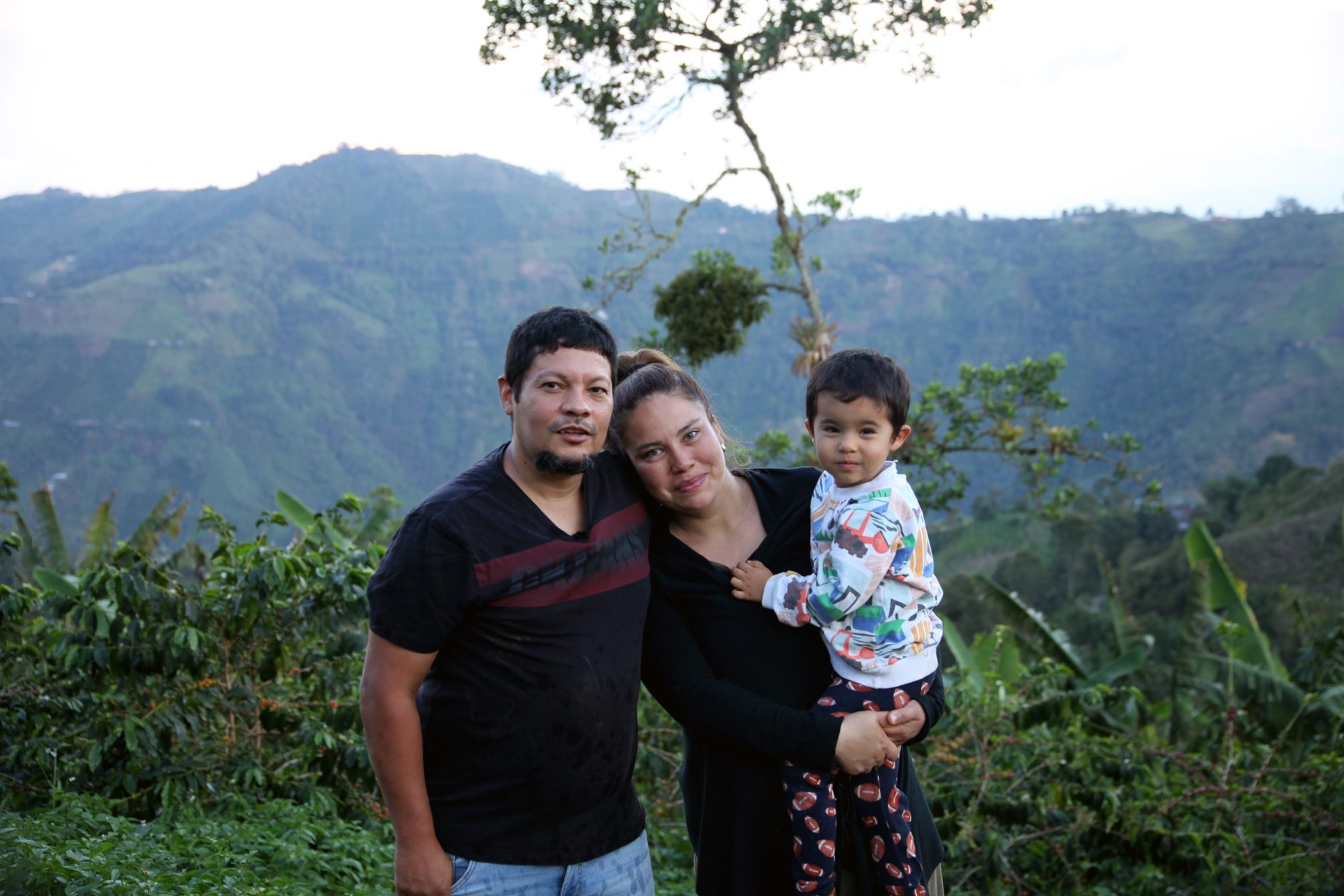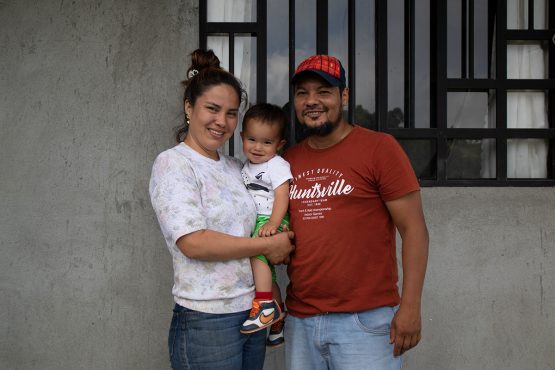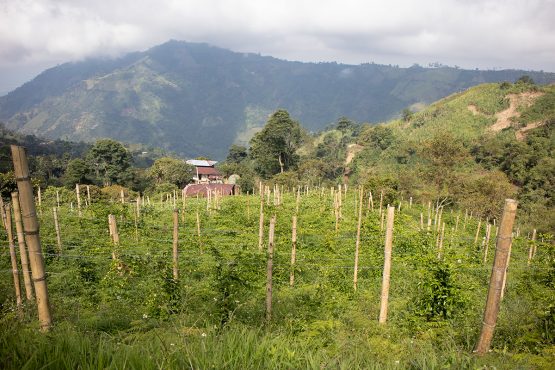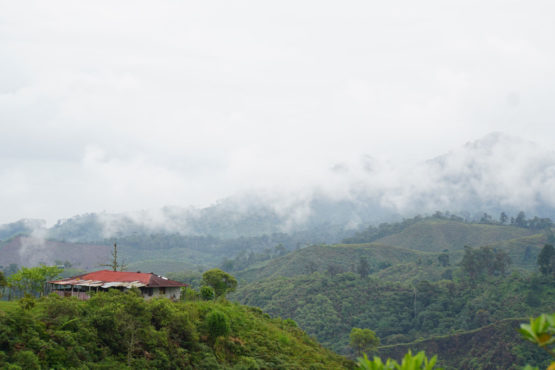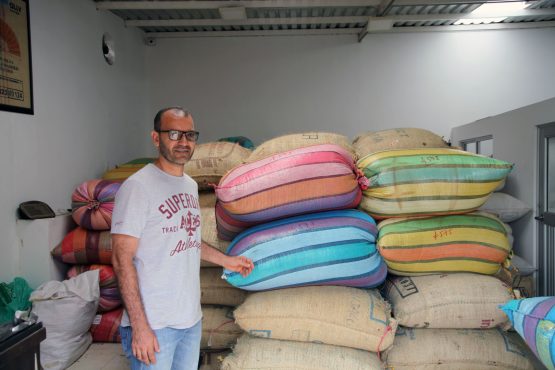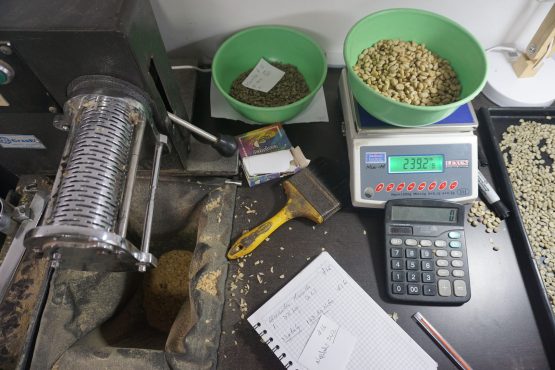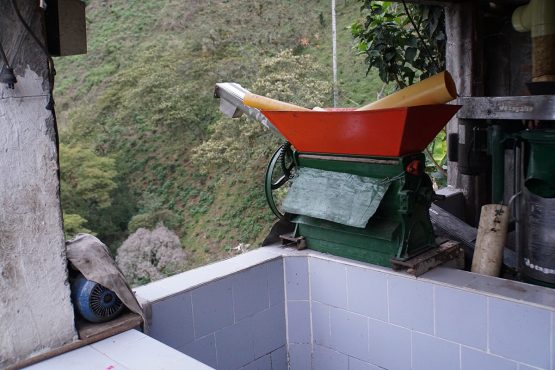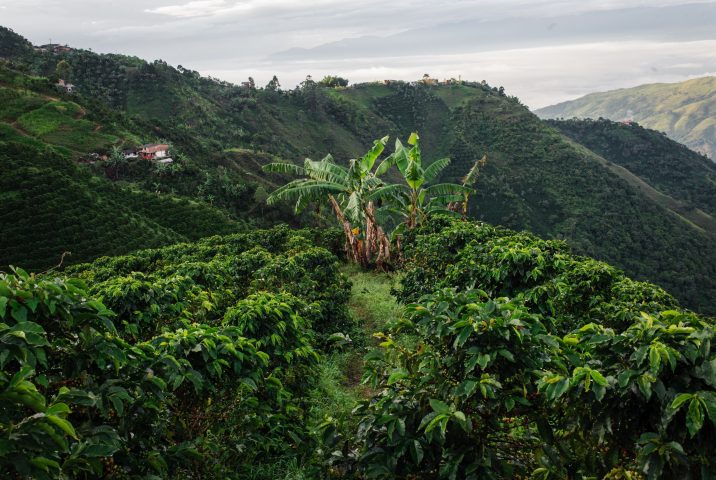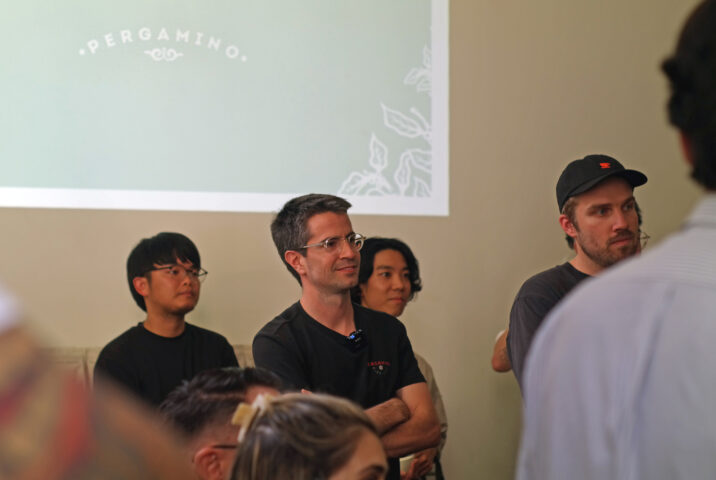Canta Ranas Chiroso
Intensely floral, with lychee, yellow peach and toffee sweetness. Refined and elegant.
This 100% Chiroso microlot was produced by Edward Sandoval on his farm, Canta Ranas, which sits on the foothills of the Los Nevados active volcano and national park, close to the small town of Santa Isabel in the north of the Colombian state of Tolima.
As Pedro Echavarría (of export partner Pergamino) puts it: “Edward is a rare breed of coffee producer.” After a long career in coffee working as a technical advisor and QC cupper for Colombia’s national coffee organisation, FNC, Edward brings a wealth of experience, insight, and expertise to the operations of his own farm.
Edward grew up on his parent’s coffee farm, El Mirador, as part of the small farming community of Santa Isabel. Edward’s father, Arsenio, inherited four hectares of land from his own father, whose larger estate was subdivided between Arsenio and his eight brothers after he passed away. Here, Edward and his brother Jorge, were taught the fundamentals of coffee production. The siblings went on to pursue careers in agriculture, with Edward focusing on coffee practices and quality assessment, and Jorge studying to become an agronomist. The family is close, and both Edward and Jorge have since established farms just a short drive away from their parent’s home.
At thirteen hectares, Canta Ranas is a relatively large estate for the area, where most farms average just three to four hectares. The land was initially established as a coffee farm in the early 1900s, but had been abandoned for many years when Edward purchased it in 2015. For the first five years of the farm’s operations, Edward relied on his brother and a hired administrator to oversee the daily tasks. During this time, he continued to work for the FNC and eventually relocated to Guatemala to work for international coffee exporter OLAM. In 2020, prompted by the pandemic, he and his family decided it was time to return to Santa Isabel and focus full time on the production of high-quality coffee. Edward, his wife Jerly, and their two children moved to Canta Ranas and built a new farmhouse to reside in – complete with a sample roaster and small cupping lab!
Quality is key to all of Edward’s practices and decisions on the farm. Over the last three years, his focus has been on updating and improving the existing infrastructure and practices, with the goal of maximising the land’s potential through higher yields and outstanding cup quality. During our visit in 2022, Edward outlined further plans for the farm, which include implementing a more sophisticated water filtration system, building new drying beds and purchasing a small silo to finish drying the coffee with more control and precision. When we returned in 2024, many of his projects had been realised, and we were impressed by the amount of growth in Edward’s business. Not only has he doubled the number of hectares under coffee, he has also expanded his drying beds and even purchased an apartment in Ibagué, for his family to reside whenever they deliver their coffee in town.
Today, ten hectares of the farm are planted with coffee, with the remaining land dedicated to plantain and a local passionfruit called ‘granadilla.’ Over 70% of Edward’s coffee trees are Chiroso, a variety that he likes because of its high productivity in Santa Isabel’s cooler climate and for its exquisite cup profile. Edward has also planted a variety garden, that includes Moka, Gesha, Wush Wush and Pink Bourbon, to test which varieties perform well in Canta Ranas’ unique conditions.
ABOUT CHIROSO
Chiroso was initially planted in the micro-region of Urrao, in Antioquia state, as it is well-suited to the cooler temperatures of the region and has higher productivity than its alternative, Caturra. It has since been recognised for its unique and complex cup characteristics and is becoming more sought after by specialty buyers. Recent DNA studies done on the variety have shown Chiroso to be an Ethiopian landrace variety (similar to the famous Gesha variety), though it is still unclear how it ended up in Antioquia, Colombia. The variety has great potential for quality, but requires a great deal of care and attention, as cherries are quick to drop, making it susceptible to strong winds and high temperatures that may lead it to ripen quickly.
ABOUT SANTA ISABEL
Santa Isabel is a beautiful and unique region in Tolima, with a terrain that is distinct to other parts of the state we source coffee from. Whereas Cajamarca and China Alta are dry and rocky, with steep cliffs at every turn, Santa Isabel is lush and verdant, with gentle, rolling slopes and cooler temperatures. This climate provides excellent conditions for agriculture and cattle raising in the region, which is known as the food pantry of northern Tolima. Along with coffee, Santa Isabel’s small community is well-known for producing dairy, beans, passionfruit (both ‘lulu’ and ‘granadilla’), and plantain.
Visiting Santa Isabel is fairly straightforward, as one of Tolima’s main highways leading straight to the town. Things become more difficult when attempting to reach farms, as the roads leading to them are unpaved and prone to be closed during the wet season, when landslides are a common occurrence. Luckily, the town’s central location gives farmers like Edward the option to deliver their parchment to a collection point in Anzoátegui, just south of Santa Isabel, or to the state’s capital, Ibagué, which is further away but with more direct access.
Historically, Santa Isabel was the home of the Panche (or Tolima) people. Like many of Tolima’s indigenous peoples, Panche society was made up of several small communities or townships nestled in the mountains. They are known for their beautiful textiles, which implement feathers from native birds, their jewellery, and their hunting skills. Though the Panche fought fiercely to protect their lands during the brutal Spanish invasion of Colombia, the majority of their communities did not survive colonisation — however, many of their artefacts and petroglyphs can still be found throughout the region of Santa Isabel.
ABOUT TOLIMA
Coffee from Tolima has historically been very difficult to access due to the region’s isolation and instability. For many years this part of Colombia was under the control of Colombia’s notorious rebel group, the FARC, and as a result, it was unsafe and violent. Since 2012, safe access to this region has been possible as a result of peace talks between the Colombian government and the rebels. Since this time some stunning coffees from small producers have become accessible to the international market.
The word ‘Tolima’ comes from the local indigenous language and means a “river of snow or cloud”. The region sits on the Cordillera Central, in the middle of the three mountain ranges that provide a range of microclimates well-suited to high-quality coffee production. Coffee is the leading agricultural activity in the region, followed by beans and cattle.
The most well-known regions in Tolima for specialty coffee are Planadas and Chaparral in the south. This coffee comes from the areas surrounding Ibagué, which is further north in the state. The city is also known as the “Ciudad del Abanico” or the “city of the folding fan” because when you look at it from the sky the rivers running from the mountains split up the crops of rice and cotton, and it looks like a beautiful handmade folding fan.
Our export partners for this coffee, Pergamino, have worked hard commercialise specialty-grade coffee throughout Tolima, and are now able to source some stunning coffees from very dedicated producers. They work closely with the producers to give them feedback on their coffees (provided by Pergamino’s expert team of cuppers) and provide top up payments when the coffee is sold at a higher premium.
During harvest, the farmers from Santa Isabel (as well as China Alta and Cajamarca) deliver lots of around 100-150kg of dried parchment to Pergamino’s Distinto Warehouse in Ibagué every two to three weeks. Upon delivery, a sample of the dried parchment is milled and assessed for physical attributes, including uniformity of size, presence of defects, moisture content and seed to hull ratio. If the coffee passes the physical assessment, it is accepted and the farmer receives their first payment for the coffee, calculated by the weight delivered and a base rate related to the physical quality of the parchment.
The coffee is then cupped and assessed for sensory attributes. Once approved, the coffees are transported to Pergamino’s QC lab in Medellin, where they are further assessed by an expert team of cuppers. Each lot is carefully evaluated and, based on the cup score and profile, the coffee is sorted into different grades of quality and combined into exportable sized lots. Feedback on each lot is relayed back to the producer, and higher scoring lots that can be sold a single producer micro lots (like this one) attract a second premium payment, which Pergamino pay directly to the producer at the end of the season.
Throughout the harvest, the team at Pergamino cups through hundreds of small lots from independent farmers, looking for coffees that exhibit excellent cup characteristics and showcase the region where they were produced. Edward Sandoval’s coffee was selected to be processed separately as a microlot for its distinct character and high cup quality, and a second price premium was paid to him to reflect this.
Head here to learn more about the work of Pergamino.
HOW THIS COFFEE WAS PROCESSED
During the harvest, Edward hires around a dozen labourers to pick coffee and assist with processing, depending on the season’s crop. These workers live in the original farmhouse during the harvest, which is almost 100 years old. Edward prefers hiring local labour, who return every year and are well trained in the correct selection of cherry. Once picked, these are processed using the washed method at Canta Rana’s ‘micro-beneficio’ (mill).
The coffee was pulped using a small pulper and then placed into a fermentation tank, where it was fermented for up to six days. Observant and meticulous, Edward tailors the number of fermentation hours for each variety he grows, as he has learned which benefit from the increased fruity and winey flavour profile, without losing complexity or inherent taste. The resulting parchment was then washed using clean water from nearby rivers and streams.
Once washed, the coffee was carefully dried (for up to 15 days) on parabolic beds, which are constructed a bit like a ‘hoop house’ greenhouse, and act to protect the coffee from the rain and prevent condensation dripping back onto the drying beans. The greenhouse is constructed out of plastic sheets and have adjustable walls to help with airflow, and temperature control to ensure the coffee can dry slowly and evenly.
The dry parchment was then delivered to Pergamino’s warehouse, where it was cupped and graded, and then rested in parchment until it was ready for export.
Canta Ranas means ‘singing frogs’ in Spanish. The natural spring which serves as a water source for the farm is also home to a family of noisy amphibians, who become particularly active when it rains. Edward named the farm in honour of these frogs!
